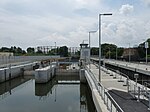Shrouds of the Somme

Shrouds of the Somme is an artwork by British artist Rob Heard which commemorates the 72,396 servicemen from the British Commonwealth with no known grave, whose names are recorded at Thiepval Memorial as missing presumed dead at the Battle of the Somme. It is estimated that more than three million men fought in the battle, and more than one million men were wounded or killed, making it one of the bloodiest battles in human history. The work comprises 72,396 small human figurines, each separately wrapped in a calico shroud which was cut and sewn by hand. The full installation was laid out at the Queen Elizabeth Olympic Park from 8 to 18 November 2018, over the centenary of the Armistice of 11 November 1918 that ended the First World War.
Excerpt from the Wikipedia article Shrouds of the Somme (License: CC BY-SA 3.0, Authors, Images).Shrouds of the Somme
Thornton Street, London Stratford Marsh (London Borough of Newham)
Geographical coordinates (GPS) Address Nearby Places Show on map
Geographical coordinates (GPS)
| Latitude | Longitude |
|---|---|
| N 51.537163888889 ° | E -0.012058333333333 ° |
Address
UCL East
Thornton Street
E20 2AF London, Stratford Marsh (London Borough of Newham)
England, United Kingdom
Open on Google Maps







